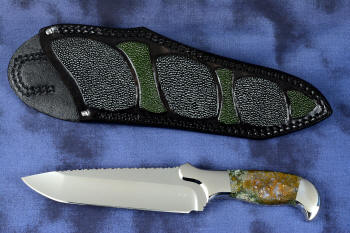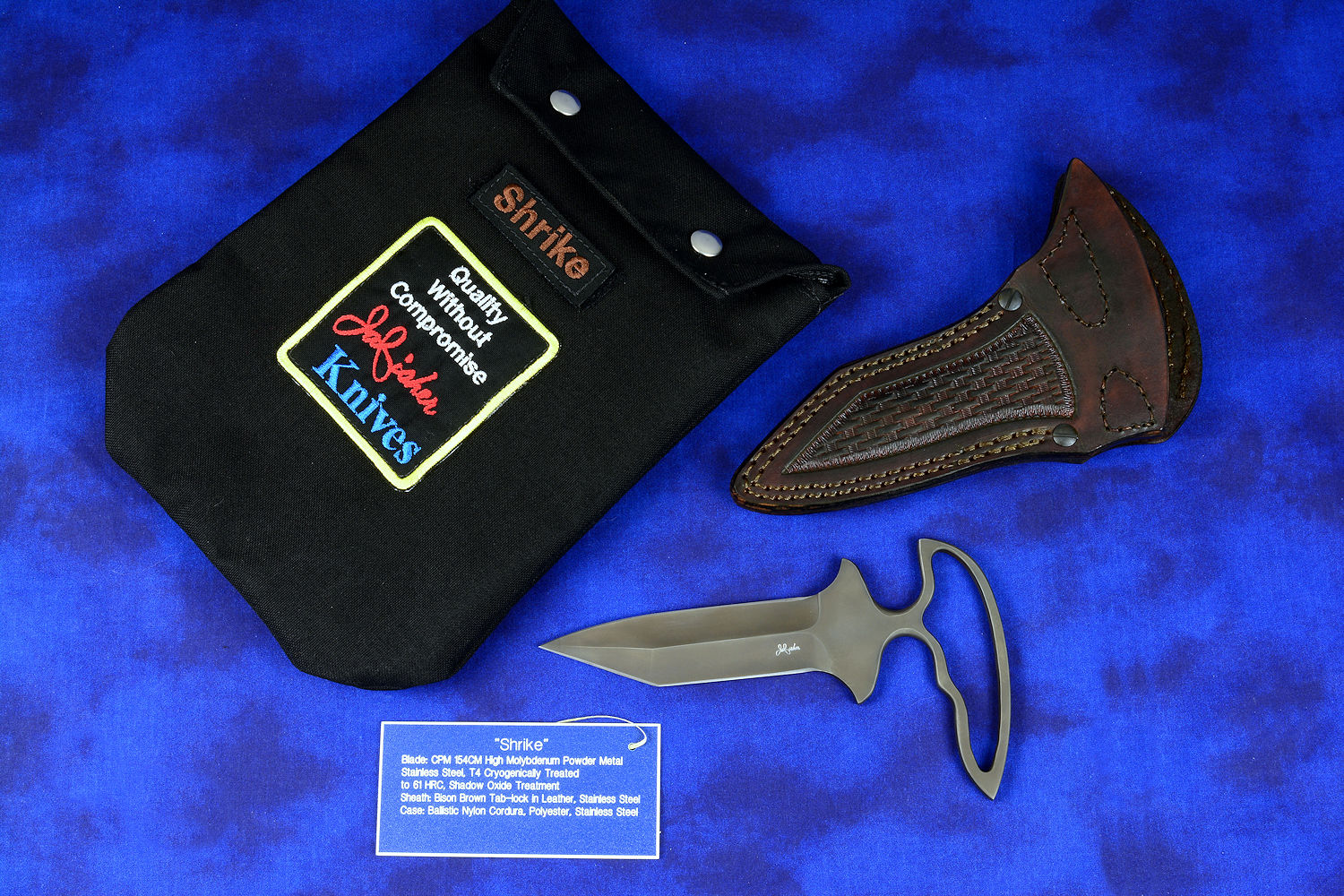Jay Fisher - Fine Custom Knives
New to the website? Start Here

"Axia"
Jay,
This is Jared Lay; my family has bought several knives from you. I bought my brother, Jeremiah Lay, a PJLT
Shank knife for him when he graduated the fire academy. Well, long story short, my brother uses the knife
all the time and just had it with him in the Philippines, after the destruction. He went into some areas
for rescue that were the first rescue people in. Just wanted you to know we love the knives you have
made and that they are doing great work across the world.
--Jared Lay
A skeleton is the bones forming the frame of a body, and in skeletonized knives, there is only the frame. Usually, this refers to only the handle, which does not typically have any fittings, bolsters, guards, scales or other material attached. Skeletonized knives are special knives, made this way for very specific reasons:
From these reasons, you can see why a skeletonized knife may be the type of knife needed. Here are some more skeletonized knives that I've made over the years in several different forms:
Just as with every type of knife, the skeletonized knife also has limitations as well as advantages. Please remember that if there were one universal, superior knife, all other knives would be discarded. Since this is an impossibility, the choice of any knife type, style, pattern, material set, and maker is based on the knife clients own specific needs. Some important considerations about skeletonized knives are:

Considering the advantages and limitations listed above, the choice of a skeletonized knife is up to the knife client. If you think that the light weight, small profile, cleanliness, and low mass is the most important aspect of your knife choice, then a skeletonized knife may be your best bet. Your custom knife maker should be able to work with you to make sure you are satisfied with the knife, understand the advantages and limitations, and create a custom work that meets your needs.
In this studio,; you can rest assured that we will do just that. If you are considering a skeletonized knife and do not see the exact form you desire, please remember that we can design new skeletonized knives based on the existing 400+ designs you can see on my Custom Knife Patterns page, as well as create hybrid knife designs based on the handle of one knife and the blade of another. We also work with new designs continually and will be glad to consider your individual needs and requirements.
Customization is another option for a skeletonized knife; we can cut or mill any appropriate visual design through a knife handle or blade, depending on the complexity and arrangement that will still support a strong handle, blade, and junction. This is an exciting customization that can include bold graphics, personal initials, and insignia of our clients.
| Main | Purchase | Tactical | Specific Types | Technical | More |
| Home Page | Where's My Knife, Jay? | Current Tactical Knives for Sale | The Awe of the Blade | Knife Patterns | My Photography |
| Website Overview | Current Knives for Sale | Tactical, Combat Knife Portal | Museum Pieces | Knife Pattern Alphabetic List | Photographic Services |
| My Mission | My Knife Prices | All Tactical, Combat Knives | Investment, Collector's Knives | Copyright and Knives | Photographic Images |
| The Finest Knives and You | How To Order | Counterterrorism Knives | Daggers | Knife Anatomy | |
| Featured Knives: Page One | Purchase Finished Knives | Professional, Military Commemoratives | Swords | Custom Knives | |
| Featured Knives: Page Two | Order Custom Knives | USAF Pararescue Knives | Folding Knives | Modern Knifemaking Technology | My Writing |
| Featured Knives: Page Three | Knife Sales Policy | USAF Pararescue "PJ- Light" | Chef's Knives | Factory vs. Handmade Knives | First Novel |
| Featured Knives: Older/Early | Bank Transfers | 27th Air Force Special Operations | Food Safety, Kitchen, Chef's Knives | Six Distinctions of Fine Knives | Second Novel |
| Email Jay Fisher | Custom Knife Design Fee | Khukris: Combat, Survival, Art | Hunting Knives | Knife Styles | Knife Book |
| Contact, Locate Jay Fisher | Delivery Times | Serrations | Working Knives | Jay's Internet Stats | |
| FAQs | My Shipping Method | Grip Styles, Hand Sizing | Khukris | The 3000th Term | Videos |
| Current, Recent Works, Events | Business of Knifemaking | Concealed Carry and Knives | Skeletonized Knives | Best Knife Information and Learning About Knives | |
| Client's News and Info | Military Knife Care | Serrations | Cities of the Knife | Links | |
| Who Is Jay Fisher? | The Best Combat Locking Sheath | Knife Sheaths | Knife Maker's Marks | ||
| Testimonials, Letters and Emails | Knife Stands and Cases | How to Care for Custom Knives | Site Table of Contents | ||
| Top 22 Reasons to Buy | Tactical Knife Sheath Accessories | Handles, Bolsters, Guards | Knife Making Instruction | ||
| My Knifemaking History | Loops, Plates, Straps | Knife Handles: Gemstone | Larger Monitors and Knife Photos | ||
| What I Do And Don't Do | Belt Loop Extenders-UBLX, EXBLX | Gemstone Alphabetic List | New Materials | ||
| CD ROM Archive | Independent Lamp Accessory-LIMA | Knife Handles: Woods | Knife Shop/Studio, Page 1 | ||
| Publications, Publicity | Universal Main Lamp Holder-HULA | Knife Handles: Horn, Bone, Ivory | Knife Shop/Studio, Page 2 | ||
| My Curriculum Vitae | Sternum Harness | Knife Handles: Manmade Materials | |||
| Funny Letters and Emails, Pg. 1 | Blades and Steels | Sharpeners, Lanyards | Knife Embellishment | ||
| Funny Letters and Emails, Pg. 2 | Blades | Bags, Cases, Duffles, Gear | |||
| Funny Letters and Emails, Pg. 3 | Knife Blade Testing | Modular Sheath Systems | |||
| Funny Letters and Emails, Pg. 4 | 440C: A Love/Hate Affair | PSD Principle Security Detail Sheaths | |||
| Funny Letters and Emails, Pg. 5 | ATS-34: Chrome/Moly Tough | ||||
| Funny Letters and Emails, Pg. 6 | D2: Wear Resistance King | ||||
| The Curious Case of the "Sandia" | O1: Oil Hardened Blued Beauty | ||||
| The Sword, the Veil, the Legend |
Elasticity, Stiffness, Stress, and Strain in Knife Blades |
||||
| Professional Knife Consultant |
Heat Treating and Cryogenic Processing of Knife Blade Steels |